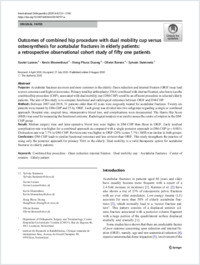Outcomes of combined hip procedure with dual mobility cup versus osteosynthesis for acetabular fractures in elderly patients: a retrospective observational cohort study of fifty one patients.
- Lannes X Department of Orthopaedic Surgery and Traumatology, Centre Hospitalier Universitaire Vaudois (CHUV), Rue du Bugnon 46, 1011, Lausanne, Switzerland.
- Moerenhout K Department of Orthopaedic Surgery and Traumatology, Centre Hospitalier Universitaire Vaudois (CHUV), Rue du Bugnon 46, 1011, Lausanne, Switzerland.
- Duong HP Institute for Research in Rehabilitation, Clinique romande de réadaptation Sion, Avenue du Grand-Champsec 90, 1950, Sion, Switzerland.
- Borens O Department of Orthopaedic Surgery and Traumatology, Centre Hospitalier Universitaire Vaudois (CHUV), Rue du Bugnon 46, 1011, Lausanne, Switzerland.
- Steinmetz S Department of Orthopaedic Surgery and Traumatology, Centre Hospitalier Universitaire Vaudois (CHUV), Rue du Bugnon 46, 1011, Lausanne, Switzerland. Sylvain.Steinmetz@chuv.ch.
- 2020-08-11
Published in:
- International orthopaedics. - 2020
Acetabular fractures
Center of rotation
Combined hip procedure
Dual mobility cup
Elderly patient
Open reduction internal fixation
English
PURPOSES
Acetabular fractures are more and more common in the elderly. Open reduction and internal fixation (ORIF) may lead to poor outcomes and high revision rates. Primary total hip arthroplasty (THA) combined with internal fixation, also known as the combined hip procedure (CHP), associated with dual mobility cup (DM-CHP) could be an efficient procedure in selected elderly patients. The aim of this study is to compare functional and radiological outcomes between ORIF and DM-CHP.
METHODS
Between 2007 and 2018, 51 patients older than 65 years were surgically treated for acetabular fractures. Twenty-six patients were treated by DM-CHP and 25 by ORIF. Each group was divided into two subgroups regarding a single or combined approach. Hospital stay, surgical time, intraoperative blood loss, and complications were documented. The Harris Hip Score (HHS) was used for measuring the functional outcome. Radiological analysis was used to assess the centre of rotation in the DM-CHP group.
RESULTS
Median surgery time and intra-operative blood loss were higher in DM-CHP than those in ORIF. Early medical complication rate was higher for a combined approach as compared with a single posterior approach in DM-CHP (p = 0.003). Dislocation rate was 7.7% in DM-CHP. Revision rate was higher in ORIF (20% versus 7.7%). HHS was similar in both groups.
CONCLUSIONS
DM-CHP leads to similar functional outcomes and less revision than ORIF. This study strengthens the practice of using only the posterior approach for primary THA in the elderly. Dual mobility is a valid therapeutic option for acetabular fractures in elderly patients.
Acetabular fractures are more and more common in the elderly. Open reduction and internal fixation (ORIF) may lead to poor outcomes and high revision rates. Primary total hip arthroplasty (THA) combined with internal fixation, also known as the combined hip procedure (CHP), associated with dual mobility cup (DM-CHP) could be an efficient procedure in selected elderly patients. The aim of this study is to compare functional and radiological outcomes between ORIF and DM-CHP.
METHODS
Between 2007 and 2018, 51 patients older than 65 years were surgically treated for acetabular fractures. Twenty-six patients were treated by DM-CHP and 25 by ORIF. Each group was divided into two subgroups regarding a single or combined approach. Hospital stay, surgical time, intraoperative blood loss, and complications were documented. The Harris Hip Score (HHS) was used for measuring the functional outcome. Radiological analysis was used to assess the centre of rotation in the DM-CHP group.
RESULTS
Median surgery time and intra-operative blood loss were higher in DM-CHP than those in ORIF. Early medical complication rate was higher for a combined approach as compared with a single posterior approach in DM-CHP (p = 0.003). Dislocation rate was 7.7% in DM-CHP. Revision rate was higher in ORIF (20% versus 7.7%). HHS was similar in both groups.
CONCLUSIONS
DM-CHP leads to similar functional outcomes and less revision than ORIF. This study strengthens the practice of using only the posterior approach for primary THA in the elderly. Dual mobility is a valid therapeutic option for acetabular fractures in elderly patients.
- Language
-
- English
- Open access status
- hybrid
- Identifiers
-
- DOI 10.1007/s00264-020-04757-w
- PMID 32772320
- Persistent URL
- https://folia.unifr.ch/global/documents/125725
Statistics
Document views: 14
File downloads:
- fulltext.pdf: 0
